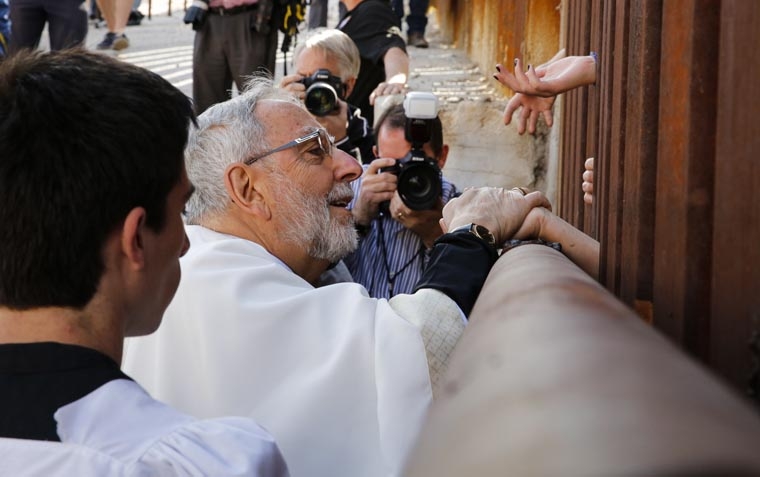WASHINGTON (CNS) — There is a reason that the song “Solidarity Forever,” sung to the tune of “The Battle Hymn of the Republic,” is an anthem of the labor movement.
And it was no accident that a June 15 conference titled “Erroneous Autonomy: A Conversation on Solidarity & Faith” was held at the headquarters building of the AFL-CIO, near the White House.
Yet, while legions of workers have for generations have been able to answer the question posed by the song — “What force on earth is weaker than the feeble strength of one?” — being able to put that solidarity into practice has come harder for America’s racial and ethnic minorities.
A century ago, Americans already mainstreamed into the nation’s social fabric were still referring to the Yugoslav or the Irish “race,” but eventually those groups, too, became part of the mainstream. For Hispanics and African-Americans, however, that has been tougher to come by.
The existence of the historic black Protestant churches are “linked to the exploitation of labor” via slavery and segregation, said Lisa Sharon Harper, who is senior director of mobilizing for the Sojourners evangelical community in Washington and was a panelist at the daylong conference.
It was slave labor that “built the foundation that made us one of the richest countries in the world,” Harper reminded her audience — riches not shared equally between America’s white and black populations today.
It was through solidarity — Harper mentioned such prominent white abolitionist ministers as William Lloyd Garrison and Charles Grandison Finney — that a nation’s conscience began to awaken from its slumber. Men like these made it clear there was “no way that you could be part of the kingdom of God, the kindom of God,” she said, “and still be a sympathizer to slavery.”
While her novel is much derided today, Harriet Beecher Stowe “moved into a space of solidarity … with those who were being exploited for their labor” with “Uncle Tom’s Cabin,” Harper added. The same was true 50 years ago when the Rev. Martin Luther King Jr. “called for ministers to walk with him” in Selma, Alabama, she said.
“This is America’s original sin. It’s the sin of racial hierarchy, coded into law. It took the form of legislative actions. It told us what was true about each other,” Harper said. “And it was a lie.” And ever since, she added, “the job has been to fight that lie and come against it.”
And what begat this racial hierarchy? Harper answered, “Fake science. Bad science.” Meaning scientific claims that blacks were inferior to whites.
Hispanics also are involved in their own struggle for solidarity.
During the June 15 conference, a Mass celebrated by several U.S. and other bishops at the Arizona-Mexico border in April 2014 was invoked several times. Images of Mexicans reaching their hands through the border fence to receive Communion from a clergyman whose feet were on U.S. soil were indelible in the minds of those who were there.
“The United States is the second largest Spanish-speaking country in the world,” said Boston College theology professor Hosffman Ospino. With Hispanics now at 17 percent of the population, they will be at 25 percent by the middle of the 21st century, he added.
The Catholic Church “already went through those numbers a long, long time ago,” Ospino noted. Hispanics account for 43 percent of all U.S. Catholics, as well as 55 percent of those under 30 and 60 percent of those 18 and under, according to Ospino. Yet, he added, only 35 U.S. parishes with a Hispanic population have a ministry to their Hispanic members.
“We need to keep in mind, because parishes are the first place Latino immigrants arrive, they need to become centers to learn not only Catholic social teaching but organizing,” Ospino said before adding, “not all Latinos in the United States are immigrants.” Still, there are “gifts the Latino community can offer to the labor movement. We must be able to affirm this,” he said.
Father Evilio Menijar, a Salvadoran-born priest of the Archdiocese of Washington, wanted to be an American before he wanted to be a priest. The first time he tried to get into the United States at age 18, making a 2,600-mile journey from his homeland to escape the ravages of civil war, he was arrested by Mexican police and thrown into one of Tijuana’s worst jails, where the only meals came from missionaries from across the border.
“I think they were Catholics because in the bag was a burrito, a bottled water and a rosary,” he quipped. But the act of solidarity touched him. Father Menijar ultimately made his way successfully into the United States, and was ordained a priest. He began his own ministry with immigrant groups whose labor is often exploited, then a few years ago became part of the first group of 28 priests given training in how to become “labor priests.”
“We know we are not taught this in the seminary,” he said.
He recalled taking part in an airline workers’ rally in downtown Washington after he had completed his training. He said the workers participating in the rally were grateful for his presence.
“Thank you, Father, for being here,” he said he was told. “It gives us courage to know the church is with us.”
But to show solidarity effectively, Father Menijar added, “we have to be in an ongoing process of conversion of mind and heart.”




